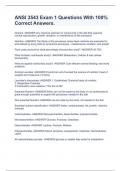ANSI 3543 Exam 1 Questions With 100%
Correct Answers.
Nutrient -ANSWER any chemical (element or compound) in the diet that supports
normal reproduction, growth, lactation, or maintenance of life processes
Nutrition -ANSWER The Study of the processes where feed nutrients are presented to
and utilized by living cells for productive processes - maintenance, lactation, and growth
Feed costs account for what percentage of production costs? -ANSWER 45-75%
What do Basic nutritionists study? -ANSWER Metabolism; Cellular & sub cellular
biochemistry
What do applied nutritionists study? -ANSWER Cost effective animal feeding; real world
problems
Antoine Lavoisier -ANSWER Frenchman who founded the science of nutrition; head of
weights and measures in France
Lavoisier's discoveries -ANSWER 1. Established Chemical basis of nutrition
2. Respiration Chamber
3.Combustion was oxidative; "The fire of life"
Essential Nutrient -ANSWER Either can not be made by the body or not synthesized in
great enough quantities to support life processes; needed in the diet
Non-essential Nutrient -ANSWER can be made by the body; not needed in the diet
Essential nutrient classification -ANSWER Water, carbohydrates, fat, protein, vitamins,
minerals
Carbohydrates -ANSWER Monosaccharides, disaccharides, polysaccharides
Monosaccharides -ANSWER Glucose, Fructose, Galactose
Disaccharides -ANSWER Lactose, Sucrose, Maltose
Polysaccharides -ANSWER Starch (amylose, amylopectin), Cellulose, Hemicellulose,
Lignin
All carbohydrates provide: -ANSWER glucose or volatile fatty acids for metabolism
, glucose -ANSWER more important for monogastrics
Volatile fatty acids -ANSWER more important for ruminants
Fat or lipid -ANSWER consist of essential fatty acids (Linoleic acid -18c, Linolenic acid-
18c, Arachidonic acid -20c)
Protein -ANSWER the 10 essential amino acids
essential amino acids -ANSWER Phenylalanine, Tryptophan, Histidine, Valine,
Isoleucine, Arginine, Threonine, Methionine, Leucine, Lysine
Minerals -ANSWER Two classes: macro (% in diet) and micro (ppm or ppb in diet)
Macro minerals (7) -ANSWER Calcium, sodium, potassium, phosphorous, chloride,
magnesium, sulfur
Micro minerals (14) -ANSWER Copper, Zinc, Iron, Iodine, Manganese, Selenium,
Cobalt, Molybdenum, Nickel, Chromium, Vanadium, Tin, Flourine, Silicon
Vitamins -ANSWER Two classes: fat soluble and water soluble
Fat soluble vitamins -ANSWER absorbed with fat: A (Vision), D (Bone), E (antioxidant),
and K (Blood clotting)
Water soluble vitamins -ANSWER Biotin, Pantothenic Acid, Vitamin B6, Choline,
Riboflavin, Vitamin B12, Folic Acid, Thiamin, Vitamin C, Niacin
Most common substance found on earth -ANSWER water
nutrient that is needed in the largest quantity -ANSWER water
Properties of water -ANSWER liquid over a large range of temperatures; high specific
heat, heat of vaporization, and surface tension; good, polar solvent
Functions of water -ANSWER transport medium, temperature regulator, lubricant, cell
turgidity and shape, and hydrolysis
water as a transport medium -ANSWER blood, lymph, interstitial fluid, intracellular fluid,
solids in gut, urine, sweat
blood is ______% water -ANSWER 90
purpose of high specific heat and high heat of vaporizatoin -ANSWER specific heat:
traps heat
heat of vaporization: releases heat




